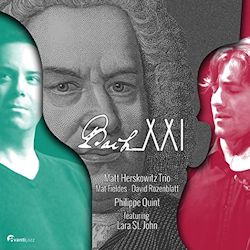-
Cello Suite no. 1 in G major, BWV 1007: Prelude
-
Cantata no. 208, “Sheep May Safely Graze”, BWV 208
-
Erbarme dich (from St. Matthew Passion, BWV 244)
-
Double Violin Concerto in D minor, BWV 1043: Vivace
-
Violin Concerto in A minor, BWV 1043: Andante
-
Duetto no. 1 in E minor, BWV 802
-
Goldberg Variations, BWV 988: Aria
-
English Suite no. 2 in A minor, BWV 807: Prelude
Matt Herskowitz – piano
Philippe Quint – violin
Matt Fieldes – bass
David Rozenblatt – drums
Lara St. John – Violin II (track 4)
Rec. 28 February to 3 March 2014, Brooklyn Recording, Brooklyn, New York [57:41]
Johann Sebastian Bach has been jazzed-up many times before, and this release can be seen in a line that includes Alec Templeton’s Bach Goes to Town, numerous recordings by Jacques Loussier and ensembles like the Swingle Singers. The use of counterpoint by jazz musicians such
as Dave Brubeck and The Modern Jazz Quartet take on Bach’s techniques, but here we’re talking about adaptation of his works into new arrangements. As the
titles for the tracks on this album suggest, these remain very much recognisable from the originals, and while there is some space for improvisation it is
Bach in jazz-style that is at the forefront of this recording.
The idea for this project came about when Herskowitz and Quint first collaborated at the El Paso Chamber Music festival in 2012, the new arrangements and
the whole thing taking shape within a short period thereafter. PR texts for this release describes BACH XXI as “a pure musical hybrid.
Pianist/arranger Matt Herskowitz reimagines 8 works of the master in contemporary settings, incorporating rhythms, grooves and harmonic voicings from Jazz,
Latin, Arab, Jewish and Contemporary Classical styles into the original scores.” Classical legitimacy and colour is provided by violinist Philippe Quint,
who joins and integrates almost seamlessly with Matt Herskowitz’s permanent trio. Comparison with jazz violinists such as Stéphane Grappelli is inevitable
in this case, but these arrangements are not intended to transform Philippe Quint into anything other than his natural, classical self. His violin soars
elegantly in melodies such as Erbarme dich from the St. Matthew Passion, but while there are extra figures and passagework at transitions it is
left to the trio to give the music a gentle, waltz-like swing. Faster tracks such as the Vivace from the Double Violin Concerto, with Quint joined
by violinist Lara St. John, are again given an intricate and groovy backing, and while there are some syncopations and nice filigree extras in the violin
parts it is Bach’s own rhythmic swing on which the whole thing is largely based. Quint proves his jazz chops further along in the track, but these are
momentary diversions.
Herkowitz outlines his principles for these arrangements in the booklet, and they can stand as good examples for others in this kind of work. He refuses to
remove music from the pieces or to ‘edit’ Bach, but allows additions to the existing structure. Bach must stay Bach, but inner voicings, harmonies and
rhythms can be altered to suit the transformation into jazz. The honesty and directness of this approach functions well, preserving the integrity of Bach’s
music while providing scope for imaginative exploration of new sonorities and colours within the pieces. This works best in arrangements such as the
eloquent version of the Duetto no. 1 in E minor, BWV 802, which is introduced in its relative simplicity, builds in intensity but retains
transparency of texture. Slower pieces such as the Aria from the Goldberg Variations are romantically tinged but avoid the worst kinds of
sentimentality. The strength in these performances is in the reserve and respect the musicians clearly have for each other, drummer David Rozenblatt
playing more the part of a rhythmic continuo by adding structure and support but, as do all of these musicians, knowing when to be quiet, and when to
listen and accommodate.
Whether you enjoy Bach in jazz form will be your call, but this is a nicely judged set of arrangements and a highly enjoyable recording in every regard.
The SACD sound is well balanced without going in for spectacular spatial fireworks – the surround effect putting you at the heart of the sessions and
making you feel as if you are the producer’s assistant.
Dominy Clements
